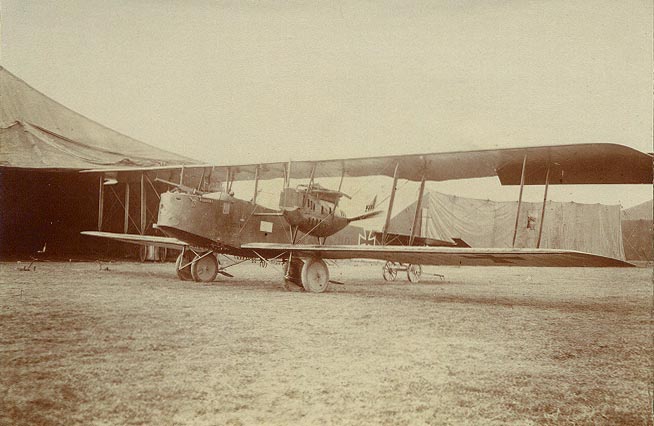- Friedrichshafen G.III
__NOTOC__ infobox Aircraft
name = G.III
type = Bomber
manufacturer =Flugzeugbau Friedrichshafen GmbH
caption = Friedrichshafen G.III
designer = Karl Gehlen
first flight = 1915
introduced =
retired =
status =
primary user = "Luftstreitkräfte "
more users =
produced = 1915 to 1918
number built =
unit cost =
variants with their own articles =The Friedrichshafen G.III (factory designation FF.45) was amedium bomber was designed and manufactured byFlugzeugbau Friedrichshafen . They were used by the German Imperial Air Service (the "Luftstreitkräfte ") during theFirst World War for tactical and limited strategic bombing operations. After the end of the war a number of Friedrichshafen bombers were converted into transport aircraft while a small number also saw service as dedicated airliners.Development
The success of the
Friedrichshafen G.II paved the way for the larger and more powerful G.III, which entered service in early 1917. While it looked somewhat similar to the G.II, the G.III was longer and had a greater wingspan which caused its designers to increase the number of inter-plane struts to three pairs on each side of the fuselage. Operational experience with the G.II had revealed a tendency for the aircraft to "nose over" during landings with deadly consequences for the nose gunner and possibly also the pilot. Friedrichshafen engineers solved this problem by equipping the G.III with an auxiliary wheel mounted under the nose gunner's position. The G.III also used the more powerful six-cylinder 260 hp Mercedes D.IVa engines. The extra power increased the bomb carrying capability enabling the aircraft to carry a bomb load of up to 1000 kg, though this severely reduced operational range. In practice the heaviest bomb load rarely exceeded 600 kg. Some of the bomb load could be carried internally but most of it was carried on removable external bomb-racks and usually consisted of streamlined P.u.W bombs but specialized munitions such asair-mine s could also be carried. As production continued further modifications were made to the G.III series that resulted in two sub-variants:Variants
Friedrichshafen G.IIIa
This sub-variant reintroduced a box-shaped biplane unit which improved the aircraft's control response when it was being flown on one engine. Another modification was the installation of a third defensive machine gun to combat British
night fighter s, which often attacked German bombers from below where they were hard to spot but the bomber's silhouette was easy to see against the night sky. This gun was mounted on a tubular, sliding mounting bolted to the floor of the rear gunner's position and was fired downward through a small sloping gun-tunnel cut into the bottom of the rear fuselage. By the last year of the war the G.IIIa had replaced the G.III in production.Friedrichshafen G.IIIb
Towards the end of the war, the G.IIIa was further modified by re-designing the rear gunner's position, which was connected to the pilot's cockpit by an open passageway.
Transport and airliner conversions
After the end of the First World War the German government and at least one commercial airline, Deutsche Luft-Reederei (DLR), operated a fleet of Friedrichshafen G.III series aircraft which were used to transport mail, high priority cargoes and the occasional passenger to and from a variety of destinations including some long distance flights to the Ukraine. For this purpose the standard G.III series bomber, usually a G.IIIa or G.IIIb, was subjected to a set of modifications ranging from the simple disarmament to fitting a rudimentary cargo compartment in place of the rear gunner's position. Some of the aircraft operated by DLR were even more extensively modified by replacing the rear gunner's position with a fully enclosed, glazed passenger cabin. Eventually all these operations were stopped by the Allies in accordance with the
Treaty of Versailles , but until then the G.III series proved itself to be a reliable and capable transport aircraft.Operations
The Friedrichshafen G.III series was ordered in large numbers from Friedrichshafen (709 ordered), Daimler (75 ordered) and Hanseatische Flugzeug Werke (280 ordered) and most of these aircraft were delivered before the war ended. A license for the production of the Friedrichshafen G.IIIa was acquired by the Oesterreichische Flugzeugfabrik A.G. (Oeffag) for the Austro-Hungarian "Luftfahrttruppe" but the project was cut short before production began by the end of the First World War.
In front-line service with the "Luftstreitkräfte" the G.III series equipped a large portion of the bomber force until the end of the war. The G.III series bombers served mainly on the Western Front where they were used to great effect, mostly in nocturnal attacks, on both tactical targets behind the Allied front-lines as well as for strategic air raids on major urban centers such as Paris. As far as is known no Friedrichshafen bombers of any type ever participated in strategic air raids on Britain because they lacked the range needed. The attacks on Britain were conducted exclusively by
Gotha G.IV and G.V medium bombers, Zeppelin Staaken R.IV heavy-bombers and Zeppelin airships. The G.III was generally well liked by its military crews for its superior load carrying capability, reliability, robustness and relatively low accident rate. These same qualities also made it popular with commercial operators during its short post-war career as transport aircraft and an airliner.Operators
*
**Luftstreitkrafte pecifications (Friedrichshafen G.III)
Aircraft specification
plane or copter?=plane
jet or prop?=prop
crew=3
length main=12.8 m
length alt=42 ftspan main=23.70 m
span alt=77 ft 9.25 inheight main=3.66 m
height alt= 12 ftarea main=95 m²
area alt=1,020 ft²empty weight main=2,695 kg
empty weight alt=5,929 lbmax takeoff weight main=3,930 kg
max takeoff weight alt=8,646 lbmore general=
engine (prop)=Mercedes D.IVa
type of prop=inline engine
number of props=2
power main=260 hp
power alt=191 kWmax speed main=135 km/h
max speed alt=83.9 mph
Wikimedia Foundation. 2010.
